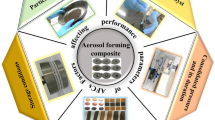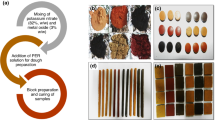Abstract
Aerosol forming compositions (AFCs) have come up as one of the most efficient fire extinguishing Halon alternative since the implementation of Montreal protocol-1987 on ozone layer depleting substances. These aerosol based systems have gained much attention in recent years because of higher fire extinguishing efficiencies, modular nature, non pressurized container, less maintenance requirement, extended shelf-life and negligible ODP, GWP and ALT values. Aerosols are traditionally produced using pyrotechnique compositions having mostly metal salts of group IA or IIA. Potassium nitrate has been used predominantly as oxidizing agent (40–75%, w/w), whereas for electric and electronics systems, strontium nitrate (15–70%, w/w) has been recommended. Versatile reducing agent, binders, gas forming agents, burn rate modifiers and many such functional additives have been used recently for preparations of AFCs. AFCs indicated variable burn rate values, 2–7 mm/s. AFCs were found highly efficient with minimum fire extinguishing concentrations mostly ranging between 30 g/m3 and 200 g/m3. Moreover, the development of highly efficient, non-corrosive, non-toxic and environmentally benign AFC is still an elusive goal. This review mainly focuses on advances of aerosol forming chemical compositions, its future prospects and potential research areas.






Similar content being viewed by others
Abbreviations
- AFCS :
-
Aerosol forming compositions
- CAFES:
-
Condensed aerosol based fire extinguishing system
- ALT:
-
Atmospheric life time
- DCDA:
-
Dicyandiamide
- GWP:
-
Global warming potential
- HMTA:
-
Hexamethylenetetramine
- ISO:
-
International Organization for Standardization
- MMAD:
-
Mass median aerodynamic diameter
- ODP:
-
Ozone depletion potential
- PFR:
-
Phenolformaldehyde resin
- PTFE:
-
Polytetrafluoroethylene
- US EPA:
-
Unites States Environmental Protection Agency
References
Kim Y, Kwon K (2012) An efficient methodology for evaluating the nozzle performance of water-based automatic fire extinguishers. Korean J Chem Eng 29:908–912. https://doi.org/10.1007/s11814-011-0276-1
Kuznetsov G V., Piskunov M V., Strizhak PA (2017) How to improve efficiency of using water when extinguishing fires through the explosive breakup of drops in a flame: laboratory and field tests. Int J Therm Sci 121:398–409. https://doi.org/10.1016/j.ijthermalsci.2017.08.004
Sheinson R, Eaton H, Black B (1993) Total flooding fire suppressant testing in a 56 m3 (2000 ft3) compartment In: Halon alternatives technical working conference, Pro., Albuquerque, NM, 137:11–13
Us FL, Hamilton DM, Fort EG, Springs T (2005) Inert gas suppression system for temperature control. Patent US9814917B2
Marlair G, Simonson M, Gann R (2004) Interflam’99 proceedings of the 10th Interflam conference, Edinburgh, 325
Web link: https://www.scribd.com/document/394977007/Pyroleaflet-pdf
Jansen S, Sr. VP of Sales at Fireaway (2011) Aerosol fire suppression technology. Fire Saf
Zhang X, Ismail MHS, Ahmadun FRB, et al. (2015) Hot aerosol fire extinguishing agents and the associated technologies: a review. Braz J Chem Eng 32:707–724. https://doi.org/10.1590/0104-6632.20150323s00003510
Hughes, W. Options to the Use of Halons for Aircraft Fire Suppression Systems (2012) Update, DOT/FAA/AR-11/31 Federal Aviation Administration. Technical Center Aviation Research Division, Atlantic City International Airport New Jersey 08405
Kwon K, Kim Y (2013) Extinction effectiveness of pyrogenic condensed-aerosols extinguishing system. Korean J Chem Eng 30:2254–2258. https://doi.org/10.1007/s11814-013-0203-8
Agafonov VV, Kopylov SN, Sychev AV (2004) The mechanism of fire suppression by condensed aerosols. In: The Halon options technical working conferences, Proceedings, 15th, Albuquerque, NM, 1–10
Williams BA, Fleming JW (1999) Suppression mechanisms of alkaline metal compounds. In: The Halon options technical working conferences, Albuquerque, NM
Zhao Y, Zhang J, Jia L (2004) Aerosol fire-extinguishing agent. Tianjin Chem Indus18(2):7
Ji T, Wei T (2013) Fire extinguishing composition of copper salts. Patent No 2013023576 A1
Shimizu, T. Fireworks (1981) The art, science and technique. T. Shimizu, Tokyo
Rusin D, Denisyuk A, Michalev D, Shepelev J (2004) Pyrotechnical aerosol-forming fire-extinguishing composite and a method of its production. Patent US 6689285B2
Denisyuk A (2003) Pyrotechnical aerosol forming fire extinguishing composite and a method of its production. Patent EU134158 A2
Conkling J, Mocella C (2013) Chemistry of pyrotechnics: basic principles and theory, 2nd ed, Marcel Dekker, INC, New York, ISBN: 13:978-1574447408
Griffiths T, Charsley E, Rumsey J (1982) International pyrotechnics seminar, Proceedings, 8th., IIT Research Institute, Chicago, 83
Griffiths T, Charsley E, Hider J (1988) International pyrotechnics seminar, Proc., 13th., IIT Research Institute, Chicago, 393
Charsley E, Hider J, Barton T, Griffiths T (1982) Journal of Thermal Analysis, Wiley, Heyden, 2:1440
Emmot P, Griffiths T, Queay J, Charsley E, Warrington S (1991) In: Proceedings of 17th international pyrotechnics seminar, Beijing Institute of Technology Press, Beijing, 25
Tichapondwa SM, Focke WW, Del Fabbro O, Labuschagne G (2016) The effect of additives on the burning rate of silicon–calcium sulfate pyrotechnic delay compositions. Propellants Explos Pyrotech 41:732–739. doi: https://doi.org/10.1002/prep.201500243
Zhang S, Shan J, Zhu Y, et al (2013) Restructuring transition metal oxide nanorods for 100% selectivity in reduction of nitric oxide with carbon monoxide. Nano Lett 13:3310–3314. https://doi.org/10.1021/nl4015292
Hasue K, Iwama A, Kazumi T (1991) Combustion aspects of sodium azide and its mixtures with potassium perchlorate and burning catalysts. Propellants Explos Pyrotech 16:245-252. https://doi.org/10.1002/prep.19910160509
Beck M, Brown M (1986) Modification of the burning rate of antimony/potassium permanganate pyrotechnic delay compositions. Comb Flame 66(1):67–75. https://doi.org/10.1016/0010-2180(86)90033-7
Rugunanan AA, Brown ME (1993) Combustion of binary and ternary silicon/oxidant pyrotechnic systems, part ii: binary systems with Sb2O3 and KNO3 as oxidants. Combust Sci Technol 95:85–99. https://doi.org/10.1080/00102209408935328
Guo H, Zheng G, Zhang W (2015) New age resistant aerosol propellant and preparing process thereof. Patent EU 2481449B1
Specht M, Meiler K (2015) Fire prevention or fire extinguishing in an electrochemical energy storage system. Patent US 2015/0017491A1
Kozyrev V, Yemelyanov V, Sidorov A, Andreev V (1998) Aerosol-forming composition for the purpose of extinguishing fires. Patent US5831209A
Sergienko A, Onjanov O (2000) Extinguishing agent for extinguishing fires comprises potassium nitrate or potassium perchlorate, hydrogen-soluble fuel, and combustion rate regulator. Patent DE 19915352A1
Drakin N.V (2000) Method and apparatus for extinguishing fires. Patent US 6089326 A
Drakin N (2000) Method and apparatus for fire extinguishing. Patent US 6116348
Drakin N (2000) Pyrotechnical aerosol-forming composition for extinguishing fires and process for its preparation. Patent EU 0976424 B1
Scheffee R, Neidert J, Black R, Lynch R, Martin J (2001) Fire suppressant compositions. Patent US 6277296B1
Belyakov V, Golubev A, Govorov K, Korobenina T, Krauklish I, Kuznetsov R, Milekhin J, Militsyn J.A, Pak Z, Perepechenko B, Rusanov V, Sokolnikov A, Soloviev V (1997) Method of extinguishing a fire and a fire-extinguishing system. Patent EU 0925808B1
Mikhailov Y, Korostelev V, Aldoshin S (2004) Aerosol generation pyrotechnic composition for systems performing volumetric fire-extinguishing, Patent RU 2230726C2
Zeliff Z, Loveless L, Kutsel V (2010) Doronichev, A. Low temperature flameless aerosol producing fire extinguishing composition and production method thereof. Patent US 20100294975A1
Kosyrev V, Emeljanov V, Sidorov A, Andreev V (1998) An aerosol forming agent for extinguishing fires and processes for its production. Patent DE 19634006 C2
Yonghua H (2011) Steam hot aerosol fire extinguishing composition and its use method and fire extinguishing device. Patent CN101554520B
Bo Z, Hongbao G, Xiaolin W, Wei H (2001) To produce a highly effective extinguishing aerosol composition. Patent CN 1288766A
Jiguo H, Yuanyang Z, Hongbao G (2011) Extinguishment combination with hot gas sol. Patent CN101376049B
Belyakov V, Rusanov V, Govorov K, Golubev A, Soloviev V, Kuznetsov R,, Krauklish I, Perepetchenko B, Militsyn Y, Milekhin Y, Korobenina (1997) Composition for fire extinguish. Patent RU2095104
Agafonov D, Doronichev A, Mikhailova M, Nikolaev S, Politova A, Zhegrov E (1999) Fire extinguishing aerosol forming means. Patent EU1109601 B1
Stepanov A, Kamensky A, Starkova A, Alikin V, Fedchenko N, Kuzmitsky G (1999) Aerosol-forming fire extinguishing composition. Patent RU 99125225/12
Guo H, Zhang Z (2010) Fire extinguishing aerosol composition for heavy current electric apparatuses. Patent US 2010/0179259A1
Ma J, Liu XR, Jin HJ, et al (2011) An improved strontium-based aerosol fire extinguishing agent with potassium additives. In: International conference on Chem Eng Adv Mater CEAM 2011, May 28, 2011–May 30, 2011 239–242:2479–2483. https://doi.org/10.4028/www.scientific.net/AMR.239-242.2479
Agafonov VV, Kopylov NP, Kopylov SN (2006) The effectiveness of condensed aerosols for fire suppression in electrical equipment, Halon Options Technical Working Conference, 15th Proceedings. HOTWC
Yongchang S, Qingqing, Gang Z, Bin C (2006) Aerosol fire extinguishing agent. Patent CN 1739820A
Guo H, Zhang Z (2013) Fire extinguishing aerosol for common electric appliance. Patent EU 2168638B1
Guo H, Zhang Z (2012) Fire extinguishing aerosol composition for precision electric appliances. Patent US8231801B2
Baratov A, Myshak I, Spector Y, Jacobson E (1995) Fire extinguishing methods and systems. Patent US5423385 A
Guo H, Liu H (2013) Ferrocene-based fire extinguishing composition. Patent US20130221264A1
Ji T, Wei T, Tian W, Liu S (2017) Metallic oxy salt fire extinguishing composition. Patent US9662523B2
Wei T, Ji T, Liu S (2017) Fire extinguishing composition containing transition metal compound. Patent US9717939B2
Wu H, Zhai T, Zheng G, Lei Z, Yang Z (2017) Fire extinguishing composition comprising heterocyclic compounds. Patent US20170043196A1
Kosanke KL, Kosanke BJ (1997) Pyrotechnic ignition and propagation: a review. J Pyrotech 6:17–19
Kibert CJ, Dierdorf D (1994) Solid particulate aerosol fire suppressants. Fire Technol 30:387–399. https://doi.org/10.1007/bf01039940
Zhu C, Wang J, Xie W, et al (2015) Improving strontium nitrate-based extinguishing aerosol by magnesium powder. Fire Technol 51:97–107. https://doi.org/10.1007/s10694-013-0361-6
Kopylov SN, Koltsov SA, Nikonova E V, Uglov VA (2003) An application of gas-aerosol tools for fire protection of sea oil-producing platforms
Jimoda L (2012) Effects of particulate matter on human health, the ecosystem, climate and materials: a review. Ser Work Liv Environ Prot 9(1): 27
Zhang J, Tan Z, Meng S, Li S, Zhang L (1997) Heat capacity and thermal decomposition of dicyandiamide. Thermo Acta 307(1): 11-15
Kopylov S, Agafonov V, Kopylov N, Uglov V, Sychev A, Zhyganov D, Nikonova EV The modification of the characteristics of the condensed fire extinguishing aerosol during its distribution through the pipelines, All-Russian scientific research institute for fire protection, Vniipo 12, balashikha district, Moscow region, 143903 Russia. https://www.nist.gov/sites/default/files/documents/el/fire_research/R0401187.pdf
Acknowledgement
Authors are thankful to Director CFEES, Delhi for his valuable guidance and permission to publish this work.
Author information
Authors and Affiliations
Corresponding author
Additional information
Publisher's Note
Springer Nature remains neutral with regard to jurisdictional claims in published maps and institutional affiliations.
Rights and permissions
About this article
Cite this article
Rohilla, M., Saxena, A., Dixit, P.K. et al. Aerosol Forming Compositions for Fire Fighting Applications: A Review. Fire Technol 55, 2515–2545 (2019). https://doi.org/10.1007/s10694-019-00843-7
Received:
Accepted:
Published:
Issue Date:
DOI: https://doi.org/10.1007/s10694-019-00843-7




